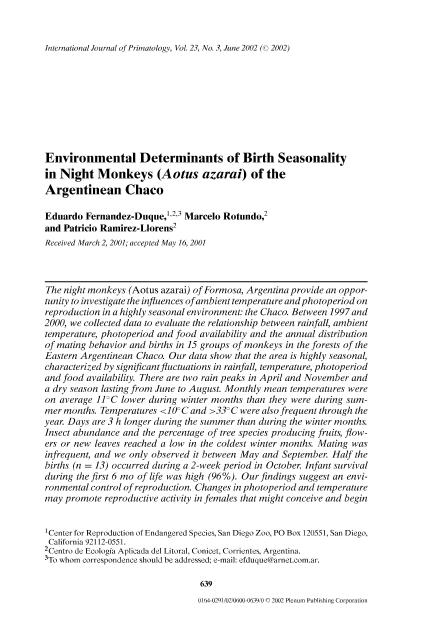Mostrar el registro sencillo del ítem
dc.contributor.author
Fernandez Duque, Eduardo

dc.contributor.author
Rotundo, Marcelo
dc.contributor.author
Ramirez Llorens, Patricio Marcelo

dc.date.available
2018-06-29T17:02:52Z
dc.date.issued
2002-06
dc.identifier.citation
Fernandez Duque, Eduardo; Rotundo, Marcelo; Ramirez Llorens, Patricio Marcelo; Environmental determinants of birth seasonality in night monkeys (Aotus azarai) of the Argentinean Chaco; Springer/Plenum Publishers; International Journal of Primatology; 23; 3; 6-2002; 639-656
dc.identifier.issn
0164-0291
dc.identifier.uri
http://hdl.handle.net/11336/50659
dc.description.abstract
The night monkeys (Aotus azarai) of Formosa, Argentina provide an opportunity to investigate the influences of ambient temperature and photoperiod on reproduction in a highly seasonal environment: the Chaco. Between 1997 and 2000, we collected data to evaluate the relationship between rainfall, ambient temperature, photoperiod and food availability and the annual distribution of mating behavior and births in 15 groups of monkeys in the forests of the Eastern Argentinean Chaco. Our data show that the area is highly seasonal, characterized by significant fluctuations in rainfall, temperature, photoperiod and food availability. There are two rain peaks in April and November and a dry season lasting from June to August. Monthly mean temperatures were on average 11°C lower during winter months than they were during summer months. Temperatures <10°C and >33°C were also frequent through the year. Days are 3 h longer during the summer than during the winter months. Insect abundance and the percentage of tree species producing fruits, flowers or new leaves reached a low in the coldest winter months. Mating was infrequent, and we only observed it between May and September. Half the births (n = 13) occurred during a 2-week period in October. Infant survival during the first 6 mo of life was high (96%). Our findings suggest an environmental control of reproduction. Changes in photoperiod and temperature may promote reproductive activity in females that might conceive and begin pregnancy at a time void of high temperatures that could be metabolically challenging.
dc.format
application/pdf
dc.language.iso
eng
dc.publisher
Springer/Plenum Publishers

dc.rights
info:eu-repo/semantics/openAccess
dc.rights.uri
https://creativecommons.org/licenses/by-nc-sa/2.5/ar/
dc.subject
Aotus
dc.subject
Birth
dc.subject
Chaco
dc.subject
Reproduction
dc.subject
Seasonality
dc.subject.classification
Zoología, Ornitología, Entomología, Etología

dc.subject.classification
Ciencias Biológicas

dc.subject.classification
CIENCIAS NATURALES Y EXACTAS

dc.title
Environmental determinants of birth seasonality in night monkeys (Aotus azarai) of the Argentinean Chaco
dc.type
info:eu-repo/semantics/article
dc.type
info:ar-repo/semantics/artículo
dc.type
info:eu-repo/semantics/publishedVersion
dc.date.updated
2018-05-21T17:22:58Z
dc.identifier.eissn
1573-8604
dc.journal.volume
23
dc.journal.number
3
dc.journal.pagination
639-656
dc.journal.pais
Estados Unidos

dc.description.fil
Fil: Fernandez Duque, Eduardo. Zoological Society Of San Diego; Estados Unidos. Consejo Nacional de Investigaciones Científicas y Técnicas. Centro Científico Tecnológico Conicet - Nordeste. Centro de Ecología Aplicada del Litoral. Universidad Nacional del Nordeste. Centro de Ecología Aplicada del Litoral; Argentina
dc.description.fil
Fil: Rotundo, Marcelo. Consejo Nacional de Investigaciones Científicas y Técnicas. Centro Científico Tecnológico Conicet - Nordeste. Centro de Ecología Aplicada del Litoral. Universidad Nacional del Nordeste. Centro de Ecología Aplicada del Litoral; Argentina
dc.description.fil
Fil: Ramirez Llorens, Patricio Marcelo. Consejo Nacional de Investigaciones Científicas y Técnicas. Centro Científico Tecnológico Conicet - Nordeste. Centro de Ecología Aplicada del Litoral. Universidad Nacional del Nordeste. Centro de Ecología Aplicada del Litoral; Argentina
dc.journal.title
International Journal of Primatology

dc.relation.alternativeid
info:eu-repo/semantics/altIdentifier/doi/http://dx.doi.org/10.1023/A:1014929902923
dc.relation.alternativeid
info:eu-repo/semantics/altIdentifier/url/https://link.springer.com/article/10.1023/A:1014929902923
Archivos asociados
